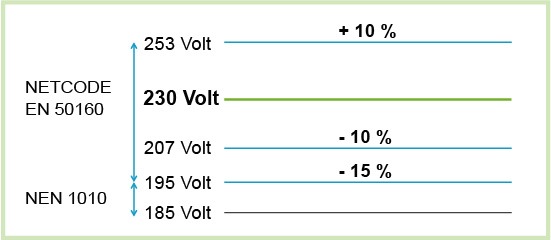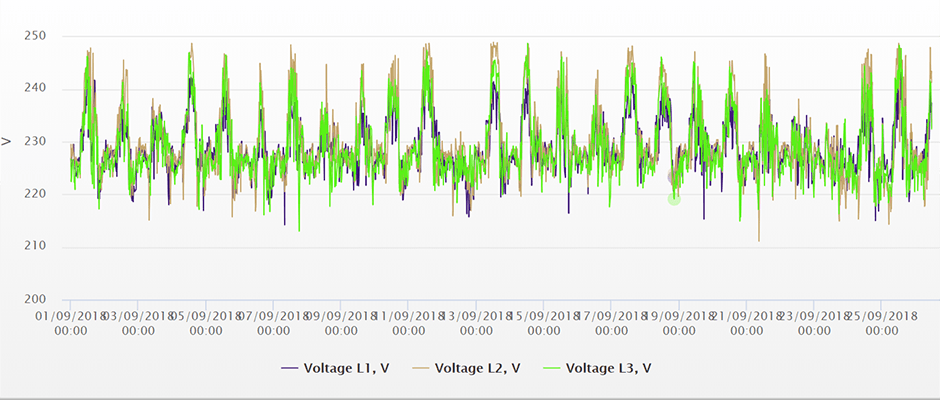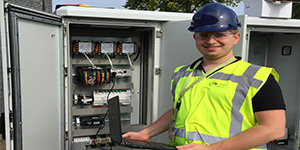Prevent malfunctions by lowering voltage levels
Voltage regulators can be used to reduce undesirably or unnecessarily high voltage levels. Excessive voltage levels can be caused by, among other things, installation of a larger number of solar panels with associated converters, or the installation being located at the start of the cable that runs from the grid operator. Reduction of excessive voltage levels contributes to improved Power Quality, sustainability and operating profit.
Advantages of installing a voltage regulator
Application at (overly) high voltage levels
High voltage levels can occur within any electrical installation, at any moment. These moments can be short (voltage peaks), but often the voltage may remain at a high level for a longer period of time. These two aspects can lead to accelerated wear of equipment and components, as well as malfunctions and equipment failure. The higher the voltage level, the more severe the consequences. With voltage levels higher than 250 Volts, the consequences can certainly be considerable. In such cases, voltage regulators provide a simple solution.

The operation of a voltage regulator
The Netherlands’ Netcode prescribes a voltage of 230 Volts ±10% during 95% of the time and always within the +10%/-15% interval. This means that the voltage, supplied by network operators, may fluctuate between 195.5 and 253 Volts. In addition, all equipment designed for the European market has to function properly within those same levels. However, higher voltage levels may result in inefficient use of electrical equipment, increasing losses and wasting energy. By installing a voltage regulator – often directly after the main switch – the voltage can be reduced by a maximum of 20 Volts. The voltage regulator then stabilizes the voltage at the level at which electrical equipment can operate most efficiently: between 215 and 225 Volts.
Curious about the possibilities?
We are happy to help you gain insight into the quality of electrical power within your installation. Through measurements, analysis and appropriate reporting, we offer you insight into the Power Quality status of your installation.
Adjustable voltage level
In the voltage regulator HyTEPS supplies, the desired voltage level can be set. Often the desired level in the voltage regulator is set to 215 Volts. However, this depends on the nature and sensitivity of connected equipment in the installation.
Regulated voltage reduction in steps
The HyTEPS voltage regulator continuously measures the supplied mains voltage and reduces it in steps of 2.5 Volts to the previously set desired voltage level. This produces a voltage with smaller fluctuations, with a positive result for the connected equipment.
No chance of voltage being too low or voltage loss
With our voltage regulator, there is no chance of voltage being too low (undervoltage). The voltage regulator will never ‘create’ a voltage lower than the set level. If the supplied mains voltage drops below the set voltage level at a given moment, the regulator will not reduce the voltage any further and this will simply run through the voltage regulator without problems. Should the voltage regulator stop working due to some unforeseen cause, this will have no further consequences. In this case, the supplied voltage simply passes through the voltage regulator to the installation.

When higher voltage levels ‘emerge’
Various situations are conceivable in which higher voltage levels can occur and installation of a voltage regulator can add value.
- At the beginning of the cable running from the network operator, the voltage will be higher than at the end of the cable. This means that the mains voltage in buildings may be higher or lower than the 230 Volt (+10%/-15%) specified in the Netcode, depending on the distance from the power supply. In addition, decentralized generation, such as solar panels, may lead to further increases in voltage. Solar panels are a voltage source and, as mentioned earlier, voltage close to the source is the highest.
- A multitude of simultaneous circuits on the network can cause a briefly elevated voltage level. This is especially common in industrial or production installations, where many devices and machines are switched on more or less simultaneously at the start of a working day.
- Installing solar panels (in large numbers) also increases the voltage. This is, of course, a modern phenomenon, which will continue to have a major impact in the coming years. The energy generated by solar panels goes back into the electricity grid. This is only possible if the voltage of the converter, connected to the solar panels, is higher than the voltage of the grid. If this goes back through converters within a single network, the voltage can become so high that it causes problems for the electrical equipment connected to the network. Installing a whole battery of solar panels can also have an adverse effect on the voltage level for the adjacent installation, at the neighbor or the company next door.
Measurement of voltage levels
It is important to first have insight into the voltage level. This is possible with basic energy meters that register voltage levels over a longer period. In many installations, there will be a clear difference between daytime and nighttime hours. Furthermore, levels on weekends will often deviate from weekdays. To obtain a good impression, a measurement with a duration of at least a week is required. But this is, of course, different for each installation. Considering the cost of a professional energy meter, the installation of an energy meter for continuous registration would be a good option to keep having insight in the future.
